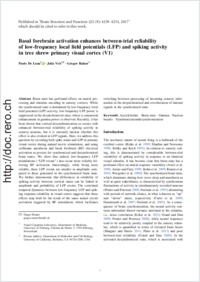Basal forebrain activation enhances between-trial reliability of low-frequency local field potentials (LFP) and spiking activity in tree shrew primary visual cortex (V1)
- Luna, Paolo De Visual Cognition Laboratory, Department of Medicine, University of Fribourg, Switzerland
- Veit, Julia Visual Cognition Laboratory, Department of Medicine, University of Fribourg, Switzerland - Department of Molecular and Cell BiologyUniversity of California, Berkeley, USA
- Rainer, Gregor Visual Cognition Laboratory, Department of Medicine, University of Fribourg, Switzerland
-
01.12.2017
Published in:
- Brain Structure and Function. - 2017, vol. 222, no. 9, p. 4239–4252
English
Brain state has profound effects on neural processing and stimulus encoding in sensory cortices. While the synchronized state is dominated by low-frequency local field potential (LFP) activity, low-frequency LFP power is suppressed in the desynchronized state, where a concurrent enhancement in gamma power is observed. Recently, it has been shown that cortical desynchronization co-occurs with enhanced between-trial reliability of spiking activity in sensory neurons, but it is currently unclear whether this effect is also evident in LFP signals. Here, we address this question by recording both spike trains and LFP in primary visual cortex during natural movie stimulation, and using isoflurane anesthesia and basal forebrain (BF) electrical activation as proxies for synchronized and desynchronized brain states. We show that indeed, low-frequency LFP modulations (“LFP events”) also occur more reliably following BF activation. Interestingly, while being more reliable, these LFP events are smaller in amplitude compared to those generated in the synchronized brain state. We further demonstrate that differences in reliability of spiking activity between cortical states can be linked to amplitude and probability of LFP events. The correlated temporal dynamics between low-frequency LFP and spiking response reliability in visual cortex suggests that these effects may both be the result of the same neural circuit activation triggered by BF stimulation, which facilitates switching between processing of incoming sensory information in the desynchronized and reverberation of internal signals in the synchronized state.
- Faculty
- Faculté des sciences et de médecine
- Department
- Département de Médecine
- Language
-
- English
- Classification
- Biological sciences
- License
- License undefined
- Identifiers
-
- RERO DOC 306284
- DOI 10.1007/s00429-017-1468-1
- Persistent URL
- https://folia.unifr.ch/unifr/documents/306227
Statistics
Document views: 69
File downloads:
- rai_bfa.pdf: 161
